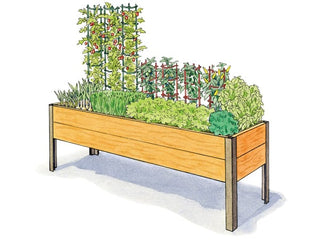Harvest fresh, healthy salads from spring to fall. Toss tender greens, crisp cucumbers and crunchy peppers, radishes and scallions into a bowl and top with your own juicy tomatoes.

Planting Guide:
Tomato
- Plant seeds 1/4" deep indoors, six to eight weeks before last frost
- Transplant into garden one to two weeks after last frost or when soil reaches 65 degrees F.
- Spacing: one plant per sq. ft. Grow early season crops nearby to allow more room later.
- Days to harvest: 55 to 100 days from transplanting, depending on variety. Not frost-hardy
- Hint: Remove lower leaves before planting and bury extra stem.
Peppers
- Start seeds indoors 1/4" deep 10 to 12 weeks before last frost.
- Transplant into garden three weeks after last frost or when soil reaches 70 degrees F.
- Fruits are edible from early green to full-color maturity.
- Spacing: one plant per sq. ft.
- Days to harvest: 50 to 65 days green, 80 to 85 days to full color. Not frost-hardy.
Kale
- Sow seeds 1/2" deep indoors eight weeks before last frost or in garden six weeks before last frost.
- Transplant seedlings into garden up to six weeks before last frost. Very frost-hardy.
- Spacing: two plants per sq. ft. Can be planted midsummer wherever early crops are removed.
- Kale continues to grow and produce leaves until late fall.
- Days to harvest: 60 days. Very frost-hardy.
- Hint: Kale can be grown in part shade. It needs plenty of moisture, so mulch well.
Cilantro
- Sow seeds directly in the garden around last frost date. Plant 1/4" to 1/2" deep. Cilantro goes to seed quickly, so plant more seeds every three weeks to ensure a constant supply.
- Spacing: Sow 18 seeds per sq. ft.; thin to nine plants per sq. ft.
- Days to harvest: 50 days for leaves, 90 days for seed harvest.
- Hint: Do not fertilize. Harvest individual stems or cut back entire plant with scissors, leaving 1" at base to regrow.
Scallions
- Start seeds 1/4" deep indoors 6 weeks before last frost; plant 5-10 seeds per cell
- Transplant plants into garden a 2 to 3 weeks before last frost. If planting sets, plant them 1" deep.
- Spacing: 16 plants per sq. ft.
- Days to harvest: 60 days, pencil-sized or larger. Frost-hardy.
- Hint: Flavor gets hotter as scallions mature. Plants require consistent moisture.
Cucumber
- Plant seeds indoors 1/2" deep three weeks before last frost, or seed in garden after frost.
- Transplant into garden after frost and when soil is 65 to 70 degrees F.
- Spacing one per sq. ft. for bush type; two per sq. ft. for vining type.
- Extend harvest with a second crop, planted two weeks later.
- Days to harvest: 50 to 60 days after transplanting. Not frost-hardy.
- Hint: Use row covers until flowering to keep off insects.
Swiss chard
- Plant seeds 1/2" deep indoors six weeks before last frost, or in garden two weeks before last frost
- Transplant: Around the time of last frost
- Plant a second crop to ensure a plentiful supply of tender leaves.
- Spacing: two plants per sq. ft.
- Days to harvest: 30 days from seed for baby; 50 days to full size. Frost-hardy.
- Hint: Good source of summer greens, chard is not bothered by heat.
Leaf lettuce
- Sow seed indoors 1/4" deep, eight weeks before last frost or directly in garden when soil can be worked.
- Thin seedlings when four weeks old.
- Spacing: 16 plants per sq. ft.
- Plant more lettuce every two to four weeks for a good supply.
- Days to harvest: 28 days for baby lettuce, 45 days to full size. Frost-hardy.
- Hint: Harvest outer leaves anytime, or use scissors to harvest entire plant, leaving an inch of stem to encourage new growth.
Mesclun mix
- Sow seed indoors 1/4" deep, eight weeks before last frost or sow directly in garden when soil can be worked.
- Thin seedlings when four weeks old. Add thinnings to salad.
- Spacing: 16 plants per sq. ft.
- Plant more mesclun mix seeds every two to four weeks for a good supply.
- Days to harvest: 28 days for baby mix, 45 days to full size. Frost-hardy.
- Hint: Harvest outer leaves anytime, or use scissors to harvest entire plant, leaving an inch of stem to encourage new growth.
Arugula
- Sow seeds directly in garden, 1" apart and 1/4" deep, starting four weeks before last frost.
- Spacing: Broadcast seed then thin to 16 per sq. ft.
- Plant a new crop every two to three weeks until midsummer; sow again in late summer for fall harvest.
- Days to harvest: 30 days to full-size leaves; small leaves are ready in 21 days. frost-hardy.
- Hint: Fall crops are less bothered by flea beetles; cover spring crops with fabric to minimize damage
Lettuce
- Sow seed indoors 1/4" deep, eight weeks before last frost or in garden when soil is 50 degrees F.
- Transplant seedlings when four weeks old.
- Spacing: Start with five seedlings, eat four as they grow and let one head mature to full size.
- Plant more lettuce seeds every two to four weeks for a continuous supply
- Days to harvest: 50 days to full size. Edible anytime. Replant every two weeks. Frost-hardy.
- Hint: Lettuce dislikes heat. Give plants afternoon shade and lots of water.
Radish
- Plant 1/2" deep directly in garden four weeks before last frost or after soil reaches 45 degrees F.
- Plant successive crops anywhere there is unused space in the garden.
- Spacing: 16 plants per sq. ft.
- Days to harvest: 21 to 28. Frost-hardy.
- Hint: Harvest as soon as possible. Roots get woody when large.





